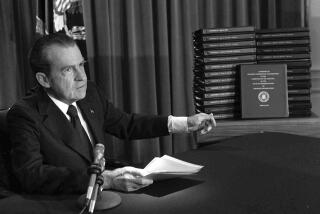National Debt Is Growing Concern
- Share via
WASHINGTON — The buds are set on the giant magnolia tree glowering over President Bush and the Oval Office. The 150-foot magnolia was planted in 1835 by Andrew Jackson because he was lonesome for a reminder of his beloved Tennessee.
With glistening leaves and its floral and aromatic revival each year, it is an imposing legacy of the seventh president. It has also gained notoriety in recent years as a marker of the last time the U.S. government had no national debt. As the economy roared through the 1990s, politicians and economists began talking about the prospect of actually eliminating the national debt for the first time since 1835, when Andrew Jackson planted that tree.
In his last official attempt to lockbox Bush 14 months ago, then-President Clinton forecast that the national debt could be fully eliminated by 2008 if his policies were pursued. As the Bush era unfolded, Federal Reserve Chairman Alan Greenspan hedged slightly. He felt that he might have a little more leverage for implementing monetary policy if the debt weren’t fully eliminated. But he agreed that it should be drastically reduced and could eventually be paid off.
The Vanishing Surplus
Alas, any hopes of actually paying off the debt vanished quicker than you can say “Old Hickory.” The January 2001 forecast of a $5.6-trillion budget surplus over the next decade was revised in February to $1.6 trillion.
In fact, the publicly held debt is climbing again--from $5.6 trillion two years ago to $5.8 trillion last year to $5.933 trillion last month.
That puts the administration in the awkward circumstance of having to ask Congress’ permission for more borrowing. The current debt limit, $5.95 trillion, was set in 1997. The administration wants to raise it by $750 billion.
That has several immediate consequences, none of them good. The government’s interest costs, which had been falling, are on the rise. The $226-billion bill for debt service is the fourth-largest spending item in the federal budget next year, behind the Defense Department, Social Security and Medicare. The spiral of anticipated deficits over the next decade has also pushed long-term interest costs higher, Greenspan said. That raises the cost of home mortgages and may also stifle the latest round of home refinancing.
Falling Along Party Lines
But the real mischief is political.
The debt limit must be raised, which is a necessity, but an embarrassment nonetheless to the Bush band of fiscal pragmatists. Democrats want to highlight that Republican embarrassment any way they can. They oppose Republicans’ idea of smothering the debt limit provision with other critical spending, such as defense or education. Some Democrats have discussed breaking the $750-billion request into smaller pieces, forcing repeated votes to gradually raise the debt ceiling.
Republican House Speaker J. Dennis Hastert (R-Ill.) wants it passed as part of larger legislation, perhaps the supplemental budget request being crafted by the administration. There is also some preliminary discussion about attaching this to a still-undefined trigger mechanism aimed at capping spending or tax cuts to curtail future budget deficits.
Treasury Secretary Paul O’Neill has started prodding House and Senate leaders to move the legislation. Democrats are in no hurry and Republicans can’t decide what to do. That makes it almost certain that the Andrew Jackson magnolia will be in full bloom before this is resolved.
More to Read
Inside the business of entertainment
The Wide Shot brings you news, analysis and insights on everything from streaming wars to production — and what it all means for the future.
You may occasionally receive promotional content from the Los Angeles Times.










